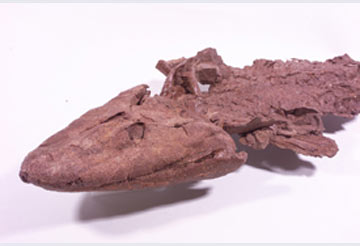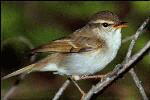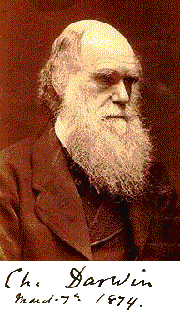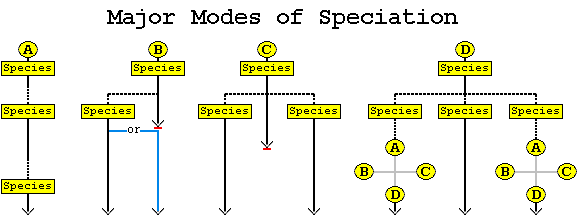No Transitionals in the Fossil Record!!!
.....Or so goes the mantra of Duane Gish, Henry Morris, Dr. Dino, Carl Baugh and to a lesser extent, Ken Ham at Answers in Genesis. Fundamentalist creationists have their own way of seeing, and of denying the physical evidence open to anyone who wishes to examine it. They like to say that dogs always come from dogs, or they claim that evolution says that man came from monkeys. For some reason they cannot understand what a family tree represents, the branching of lineages. Given sufficient time, the change in lineages can be immense. There was a time when, in some respects, the fossil evidence was scant. Today we have marvelous series of transitional or intermediate forms in many diverse lineages.
Stephen Jay Gould : The supposed lack of intermediary forms in the fossil record remains the fundamental canard of current antievolutionism. Such transitional forms are sparse, to be sure, and for two sets of good reasons � geological (the gappiness of the fossil record) and biological (the episodic nature of evolutionary change, including patterns of punctuated equilibrium, and transition within small populations of limited geographic extent). But paleontologists have discovered several superb examples of intermediary forms and sequences, more than enough to convince any fair-minded skeptic about the reality of life�s physical genealogy.
|
To demonstrate how undeniably there are numerous series of transitional forms, I have gathered below a group of links to webpages and websites dealing in specific cases -- such as my dino-to-birds and transitional whales pages. Even these, I must admit, are somewhat inadequate to the task of demonstrating to those without eyes to see. The detailed evidence is in museums all over the world. The published evidence (just for the past few years) is enormous. I've listed some of the recent papers from a few scientific journals -- the tip of the iceberg.
Hominid Transitionals These are the ancestors of humans. The new fossil discoveries are coming at a rate that make it difficult to keep the family tree up-to-date. About 18 transitional species and counting! This page presents for each homind fossil species extensive links to online evidence and to many accessible scientific papers. There is a current book list, and sections dealing with DNA evidence and taxonomy and classification.
Horses and More Horses. : Horses returned to the Western Hemisphere with the Spanish explorers, long after they had gone extinct in both North and South America. They are still one of the best series of transitional fossils, although we now know that their evolution was not as steady ladder of progress.
Dinosaurs-to-Birds. Transitional Fossils and Feathers. : Yes, it is true, dogs do not become cats. But dinosaurs did become birds. This was not "within kinds" evolution. There are hundreds of fossil specimens involving dozens of species demonstrating this transition.
The Loss of Limbs: Transition from lizards to snakes. : Were the ancestors of modern snakes legged terrestrial lizards, or were they marine forms related to the mosasaurs?
From Land to Sea: the Case for Whale Transition. : Transitional fossils not only show the skeletal intermediacy in the legs/feet-to-flipper transition, but also demonstrate how organs such as the ears and breathing apparatus changed with time.
As Stephen Gould concludes, "If you had given me a blank piece of paper and a blank check, I could not have drawn you a theoretical intermediate any better or more convincing than Ambulocetus. Those dogmatists who by verbal trickery can make white black, and black white, will never be convinced of anything, but Ambulocetus is the very animal that they proclaimed impossible in theory." (Natural History, May 1994.)
|
|
|
Gaining Ground: The Origin and Evolution of Tetrapods : This is the story about how our ancestors evolved legs in the sea before emerging to life on land. This page is in large measure a report on the current book by this title, written by Jennifer Clack of the University Museum of Zoology, Cambridge, UK. This page is nicely supplemented by information in the next page by Glenn Morton.
Transitional Forms: Fish to Amphibians : Fundamentalist creationists claim that there are no transitional forms. The plain fact is that there are transitional sequences but they never discuss the details. This is a sequence of fossils which occupy the transition from fish to amphibian. [At the time Glenn Morton wrote this his reference citations went only to 2000. Since then several important new fossils have been found and reported in the Journals Science and Nature. Romer's Gap, a 20 million year period for which there had been a paucity of transitional tetrapods, has now been closed]
Tiktaalik: the newest evidence. The pefect transitional between advanced fishes and primitve amphibians. This site has information on the fossil, the expedition and the scientists involved.
 Courtesy tiktaalik.uchicago.edu Courtesy tiktaalik.uchicago.edu
|
Living Transitional Species -- Observing Evolution Now



For evidence of observed evolution NOW see my page dealing with Living Transitionals. The map hints at just a few cases involving Palearctic Gulls, Greenish Warblers and Ensatina Salamanders. But you can also look into cases involving fruit flies, field crickets, tree frogs, salmon and other fishes, Darwin's Finches, cicadas, South American rats and other plants and animals. Be sure not to miss the wonderful Cichlids.
|
|
Smooth Transitional Series
|
|
Forams: Smooth and "Fast" Transitions : If you have time to read just one article, read this one about the discovery of a complete, unbroken sequence of "forams". (There is also a second article.) The sequence for Foraminifera is 66 million years long, and includes about 330 species. The Glorious Fossil Record: Tracing Evolution offers additional commentary that is relevant here.
Pelycodus: Typical Transitionals : As you scan upward, you will see that each group has some overlap. There are no major breaks or sudden jumps. And the form of the creatures was changing steadily.
Stasis: A Pliocene Snail : If there had been gaps in the fossil sequence, we would have thought that these were fossils from several different species. If we look at snails alive today, we can find separate species which differ by less than the difference shown in the picture.
Eocoelia: 10 Million Years of Evolution : The data is from fossils gathered at thirteen different depths. As is usual in geology, the diagram gives the data for the deepest (oldest) fossils at the bottom, and the upper (youngest) fossils at the top. The diagram covers about ten million years.
Radiolarian: Branching in Fossil Record : A Plankton Becomes Two Species. A Radiolarian is a single-celled plankton. The diagram shows a new and larger species, Eucyrtidium matuyamai, slowly branching off from the species Eucyrtidium calvertense.
Orbulina: Intermediates of Intermediates : Much of the ocean bottoms have been undisturbed for tens of millions of years, so complete sets of intermediate fossils are found at many locations around the world.
Smooth Change in the Fossil Record : Species are not immutable. They can change across time. And, a species can split in two. Gradations pose a problem to the idea that all of the fossilized creatures were alive at once. That idea allows no time to have passed -- and these changes must have happened over time. This page links to all pages in Dave Lindsay's series which are listed individually above. And this page Species and Genus Level Evolution in the Fossil Record provides still more evidence.
|
Overviews of Transitional Fossil Evidence Elsewhere
|
Taxonomy, Transitional Forms, and the Fossil Record : by Keith B. Miller. Numerous cases of speciation are presented, and often illustrated with the work of Alfred Romer. While the quality of the illustrations in this file leave much to be desired, Dr. Miller does a more than adequate job of relating the facts.
Transitional Vertebrate Fossils FAQ : by Kathleen Hunt. Best on the web at www.talkorigins.org.
29 Evidences for Macroevolution : This article directly addresses the scientific evidences in favor of macroevolutionary theory and common descent. It is specifically intended for those who are scientifically minded but, for one reason or another, have come to believe that macroevolutionary theory explains little, makes few or no testable predictions, or cannot be falsified. A FAQ at www.talkorigins.org.
Skull Central : The Digital Morphology Group at the Univ. of Texas, Austin, has built a library of the skeletons of both modern and fossil vertebrates. There is also an anatomical tutorial to Thrinaxodon, a 245-million-year-old creature that is transitional between mammals and their ancestors.
|
|
Current Books About Speciation
|
|
The Cichlid Fishes: Nature's Grand Experiment in Evolution by George W. Barlow
Systematics and the Origin of Species by Ernst Mayr
The Evolution Explosion by Stephen R. Palumbi
Frogs, Flies and Dandelions by Menno Schilthuizen
The Beak of the Finch : Evolution in Our Time by Jonathan Weiner
The Diversity of Life by Edward O. Wilson
|
| |





 Courtesy tiktaalik.uchicago.edu
Courtesy tiktaalik.uchicago.edu
